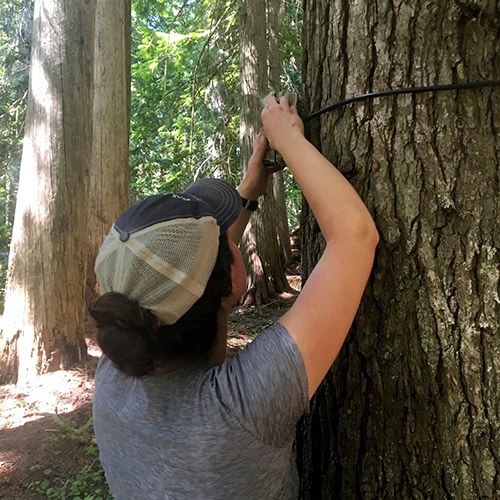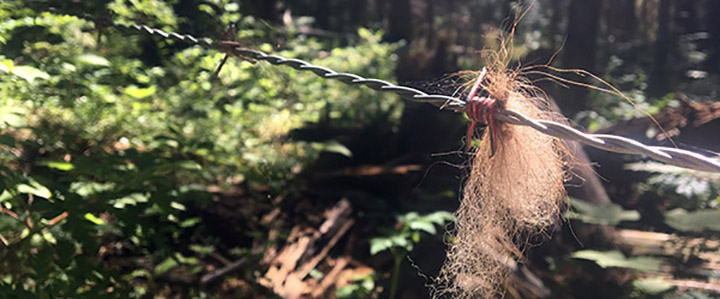Deep in north Idaho’s Selkirk mountains, a tuft of coarse dark brown bear hair blows gently in the wind on a piece of barbed wire.
Nearby, Y2Y’s Cabinet Purcell Mountain Corridor project coordinator Jessie Grossman moves along the forest floor, examining the pieces of barbed wire stretched around four trees to make a square.
Nearby, Y2Y’s Cabinet Purcell Mountain Corridor project coordinator Jessie Grossman moves along the forest floor, examining the pieces of barbed wire stretched around four trees to make a square.
On this morning Jessie and U.S. Fish and Wildlife Service seasonal technician Megan Wright (pictured at right) have been bushwhacking and travelling far off trail to access this remote site known as a corral, the first of the weekend.
The pair are collecting bear hair samples in this band of mountains as part of an ongoing DNA project in a region known as the Selkirk grizzly recovery zone.
Inside the corral, logs are soaked in fermented fish and other strong-smelling ingredients. It’s not immediately noticeable to humans, but for a bear’s super sensitive nose, it’s just right.
The wire is carefully set — low enough for a bear to snag its fur on while crawling under yet high enough to discourage the bear stepping over. The corral is deep in the woods, far from popular recreation areas to prevent conflict with wildlife.
What does bear hair tell us?

Since 2012, the U.S. Fish and Wildlife Service have been leading this monitoring program. This summer, Megan’s job is to set up corrals and monitor rub trees.
Both of these sites allow for the collection of grizzly bear fur for DNA analysis. These samples help biologists track bears in the ecosystem, find new bears, and monitor which bears are breeding and producing offspring.
“This area is prime grizzly habitat,” says Jessie. “By capturing passing bears on remote wildlife cameras, and taking hair samples from wire catches and natural tree rub sites, we can observe and track their recovery.”
This monitoring is part of a recovery plan that started in 1993 when the grizzly population was about 36 bears. Thanks to the support of our donors, Y2Y — along with agency partners and other non-profits — works to help protect and connect habitat for grizzlies in the larger Cabinet-Purcell Mountain Corridor.
This project is ongoing in the Cabinet-Yaak and Selkirk recovery zones of northeast Washington, northern Idaho and northwest Montana, even crossing into British Columbia.
Grizzly bears bouncing back
The good news? It’s been working. There are now an estimated 70 to 80 grizzlies living in the entire cross-border ecosystem.
In addition to checking natural rub sites — bears often travel many miles to rub a particularly good tree to get that itch just right (see video link to right) — Jessie and Megan are collecting photos from remote cameras that trigger when wildlife visit the corral site.
On this day, the team finds photographic evidence of several moose and black bears. Though there was no evidence of grizzlies on the wildlife cameras, the hair sample is collected to undergo DNA analysis.
Jessie and Megan carefully lift coarse brown hair with a white tip off the wire snag. It looks like grizzly hair.
“This is exciting to find,” Jessie says. “Maybe one day we’ll be regularly collecting hair at this site as bears continue to bounce back into their traditional territory here.”


